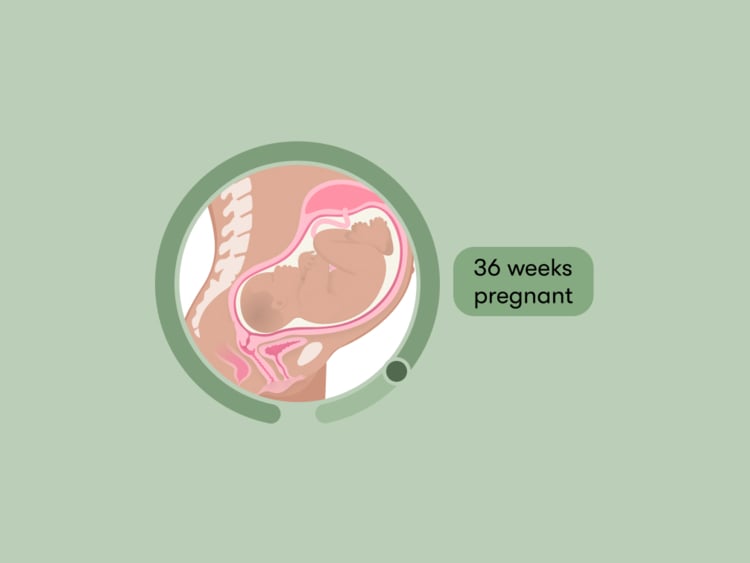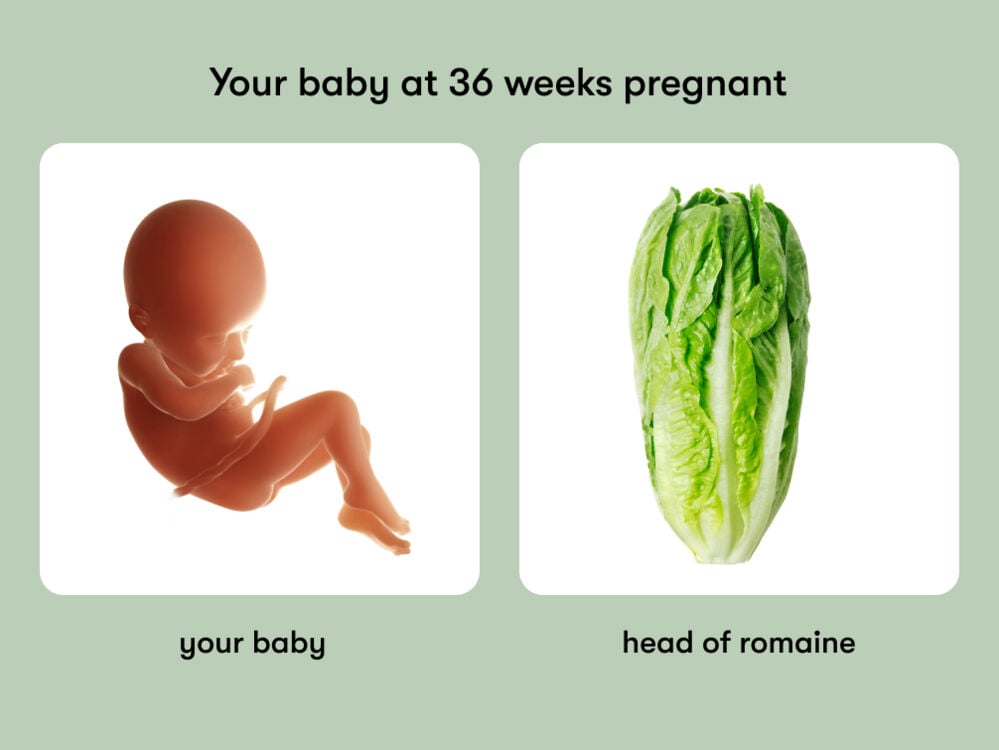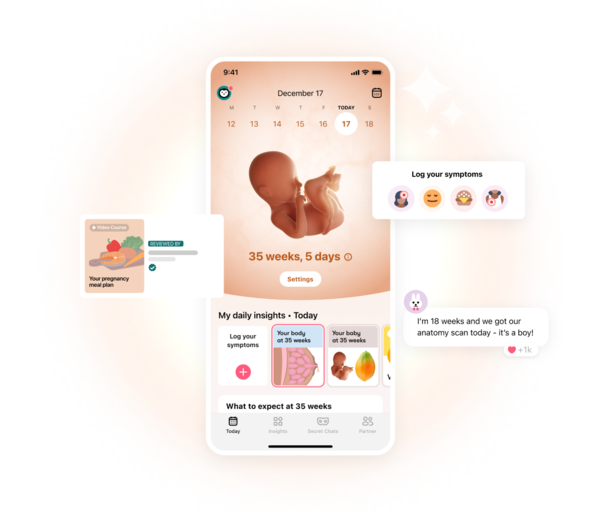From posture changes to packing your hospital bag, here’s the lowdown on being 36 weeks pregnant.
-
Tracking cycle
-
Getting pregnant
-
Pregnancy
-
Help Center
-
Flo for Partners
-
Anonymous Mode
-
Flo app reviews
-
Flo Premium New
-
Secret Chats New
-
Symptom Checker New
-
Your cycle
-
Health 360°
-
Getting pregnant
-
Pregnancy
-
Being a mom
-
LGBTQ+
-
Quizzes
-
Ovulation calculator
-
hCG calculator
-
Pregnancy test calculator
-
Menstrual cycle calculator
-
Period calculator
-
Implantation calculator
-
Pregnancy weeks to months calculator
-
Pregnancy due date calculator
-
IVF and FET due date calculator
-
Due date calculator by ultrasound
-
Medical Affairs
-
Science & Research
-
Pass It On Project New
-
Privacy Portal
-
Press Center
-
Flo Accuracy
-
Careers
-
Contact Us
36 weeks pregnant: Your guide to this week of your third trimester


Every piece of content at Flo Health adheres to the highest editorial standards for language, style, and medical accuracy. To learn what we do to deliver the best health and lifestyle insights to you, check out our content review principles.
When you’re 36 weeks pregnant, you may well have started counting down the days until your due date. It can feel like an exciting time, but it’s natural to find it overwhelming at points too. From feeling nervous about labor and birth to remembering to massage your perineum, it’s natural to have a lot on your mind right now. Keep scrolling to find out what you might experience this week, with advice from a Flo expert.
Your baby at 36 weeks pregnant
Baby’s lungs are structurally mature
It’s a big week for your baby’s development, as the basic structure of their lungs is now mature. However, they’re not totally ready to breathe in the outside world just yet, as their lungs will continue to develop up to full term (39 weeks).
Baby can recognize tastes
By now, your little one’s taste buds are well developed. They’re currently receiving flavors via the amniotic fluid surrounding them in your uterus, but soon enough it could be your breast milk that tickles their taste buds.
How big is a baby at 36 weeks?
Length (crown to heel): 47.3 cm or 18.6 in
Weight: 2.8 kg or 6.2 lb
Size: Equivalent to a head of romaine
All measurements are approximate and vary within the normal range.

Your body at 36 weeks pregnant
Posture changes
You may have noticed your posture change during pregnancy, which is a normal and gradual process, as our Flo expert explains. “As your pregnancy progresses, your lower back will gradually start to curve more, and your shoulders may also move back a bit to make up for your shifting center of gravity and enlarging uterus,” says Dr. Jenna Beckham, obstetrician and gynecologist, WakeMed, North Carolina, US.
She adds, “The abdominal muscles sometimes separate, which can lead to a change in posture.” The separation is caused by your growing uterus pushing the muscles apart. By the time your baby is eight weeks old, the muscles will usually have gone back to normal.
However, it’s also normal not to have this pregnancy symptom, especially if you’ve been mindful of your posture during your pregnancy. Good posture during pregnancy is all about holding the position that puts the least strain on your back. Small adjustments like keeping your shoulder blades back, pushing your chest forward, pulling in your stomach, and tucking your butt in can help you support the weight of your bump. Think of it as the best kind of power pose!
Back pain
One of the reasons it’s so good to modify your posture during pregnancy is because it can help reduce back pain. But posture isn’t the only cause of pregnancy back pain. “In most cases, back pain is due to mechanical factors resulting from altered posture, muscle weakness, joint looseness, and vertebral facet joint irritation [in other words, irritation of parts of the spine],” says Dr. Beckham.
This can be frustrating, but luckily, there are several things you can try at home. “Back pain can be managed with rest, exercise, massage, physical therapy, or painkillers,” says Dr. Beckham. If you’re not experiencing this symptom, that doesn’t mean anything is wrong. In fact, it’s just a reason to count yourself lucky.
Your questions answered
Is 36 weeks OK for delivery?
Yes, it is possible to safely deliver your baby at 36 weeks pregnant, but their birth would be considered late preterm. However, at this stage in your pregnancy, they’d be less likely to need specialist care in a neonatal unit or have severe problems that can occur with premature births, compared to babies born at 34 or 35 weeks.
By this point, your baby’s development has come a long way. Their digestive system is fully developed, and the basic structure of their lungs is mature. So while only 7% of babies are born around this time, it can be reassuring to know that they’d most likely be fine if they were born at 36 weeks.
What should you be feeling at 36 weeks pregnant?
Wondering what to expect in terms of other pregnancy symptoms? As with other weeks during your pregnancy, there are a number of things you may be feeling at 36 weeks pregnant. Every pregnancy is different, so if you can, try not to compare yourself too much to others. The following are examples of some of the pregnancy symptoms you may be experiencing, but it’s perfectly normal if you don’t notice any of these:
- Braxton Hicks contractions (i.e., false labor contractions in your belly)
- Swollen ankles and feet
- Feeling hot
- Bloating and constipation
- Mood swings
- Dizziness
What week is most common to go into labor?
Most women give birth between 38 and 41 weeks of pregnancy, which is early term to full term. So you could be getting super close to the finish line! Just to remind you, deliveries are often classified in the following way:
- Extremely preterm: less than 28 weeks
- Very preterm: 28 to 31 weeks and 6 days
- Moderate to late preterm: 32 to 36 weeks and 6 days
- Early term: 37 weeks to 38 weeks and 6 days
- Full term: 39 weeks to 40 weeks and 6 days
- Late term: 41 weeks to 41 weeks and 6 days
- Post-term: 42 weeks and beyond
Take a quiz
Find out what you can do with our Health Assistant
36 weeks pregnant checklist
Mix up meals
Keen to raise a little foodie or simply avoid having a fussy eater in the family? When you eat a balanced diet that includes all the major types of nutrients during pregnancy and breastfeeding, it can stimulate your baby’s taste buds. This may then promote their future curiosity for different flavors. So if you fancy mixing up your meals, why not take yourself on a little culinary journey? It could pay off big time in the future.
Prep meals to pop in the freezer
While we’re on the subject of meals, once your baby arrives, you might not feel like you’ve got the time (or energy!) to cook for yourself. Future you will likely be very grateful for a fully stocked freezer! From chili and soups to casseroles, there are plenty of delicious and healthy meals that are easy for expecting parents to batch-cook and freeze.
Pack your baby’s hospital bag
Now could be a good time to start packing a hospital bag for labor. Starting the process early can make it less stressful (and more fun!). Let’s take a look at some of the key things you may want to think about.
Things to pack for yourself
This can include:
- Three changes of comfy clothes and five or six pairs of underwear
- A robe and slippers
- A bag with all your favorite toiletries
- Healthy snacks and drinks
- Any medication that you’re taking
- Extra pillows
- Notes on your birth plan
Things to pack for your baby
This can include:
- Clothes like onesies and sleep suits
- Diapers
- A shawl or blanket
- A car seat for the journey home
Things you’ll need if you’re planning a home birth
This can include:
- Two packets of highly absorbent period or maternity pads
- Clothes for your baby
- Clean bedsheets
- Clean towels
When to consult a doctor at 36 weeks pregnant
Right now, you may be having a checkup with your doctor every week. However, how often you see your doctor will depend on where you live, as well as what you and your doctor decide is right for you and your baby.
You don’t need to wait until your appointment if you have any concerns or questions about your pregnancy. However, at 36 weeks pregnant, you should contact your doctor immediately if you experience:
- Severe cramping
- Vaginal bleeding
- Changes in vaginal discharge
- Fever
- Dizziness or fainting
- Severe vomiting
- Severe headaches or blurry vision
- Intense heartburn
- A decrease in the amount you feel your baby move
- A loss of liquid from your vagina or watery/mucus-like discharge (this could be a sign of premature labor)
This isn’t an exhaustive list and just an example of some of the changes you should look out for. Some of these can be a sign of health complications, so it’s essential that you speak to your doctor about the best next step for you. And if you’re ever worried about any other symptoms you experience during pregnancy, then don’t hesitate to reach out to your health care provider.
36 weeks pregnant: The takeaway
At 36 weeks pregnant, you’re just a couple of weeks away from the period when most babies are born! It might feel like there’s still lots to do to prepare for labor and your baby’s arrival, but try not to panic. The best way forward can be to take a deep breath and try to enjoy steadily checking things off your to-do list.


Hey, I'm Anique
I started using Flo app to track my period and ovulation because we wanted to have a baby.


The Flo app helped me learn about my body and spot ovulation signs during our conception journey.


I vividly
remember the day
that we switched
Flo into
Pregnancy Mode — it was
such a special
moment.
Real stories, real results
Learn how the Flo app became an amazing cheerleader for us on our conception journey.
References
“33 to 36 Weeks Pregnant.” Health Service Executive, www2.hse.ie/pregnancy-birth/baby-development-pregnancy-stages/stages/33-36-weeks/. Accessed 18 July 2023.
“Week 36.” NHS, www.nhs.uk/start-for-life/pregnancy/week-by-week-guide-to-pregnancy/3rd-trimester/week-36/. Accessed 18 July 2023.
“Back Pain during Pregnancy.” The American College of Obstetricians and Gynecologists, May 2020, www.acog.org/womens-health/faqs/back-pain-during-pregnancy.
“Back Pain in Pregnancy.” NHS, www.nhs.uk/pregnancy/related-conditions/common-symptoms/back-pain/. Accessed 18 July 2023.
“Bleeding during Pregnancy.” The American College of Obstetricians and Gynecologists, May 2021, www.acog.org/womens-health/faqs/bleeding-during-pregnancy.
Curran, Mark A. “Fetal Development.” Perinatology.com, perinatology.com/Reference/Fetal%20development.htm. Accessed 18 July 2023.
“Definition of Term Pregnancy.” The American College of Obstetricians and Gynecologists, Nov. 2013, www.acog.org/clinical/clinical-guidance/committee-opinion/articles/2013/11/definition-of-term-pregnancy.
“Diastasis Recti.” Cleveland Clinic, my.clevelandclinic.org/health/diseases/22346-diastasis-recti. Accessed 18 July 2023.
Escobar, Gabriel J., et al. “Short-Term Outcomes of Infants Born at 35 and 36 Weeks Gestation: We Need to Ask More Questions.” Seminars in Perinatology, vol. 30, no. 1, Feb. 2006, pp. 28–33, doi.org/10.1053/j.semperi.2006.01.005.
“Freezable Recipes for New Parents.” BBC Good Food, www.bbcgoodfood.com/howto/guide/freeze-ahead-recipes-parents-be. Accessed 19 July 2023.
Friel, Lara A. “Fevers during Pregnancy.” MSD Manual Consumer Version, Oct. 2021, www.msdmanuals.com/home/women-s-health-issues/pregnancy-complicated-by-disease/fevers-during-pregnancy.
“How to Tell When Labor Begins.” The American College of Obstetricians and Gynecologists, May 2020,
www.acog.org/womens-health/faqs/how-to-tell-when-labor-begins.
“How Often Do You Need Prenatal Visits?” Cleveland Clinic, 14 Jan. 2022, health.clevelandclinic.org/prenatal-appointment-schedule/.
“Kick Counts.” Cleveland Clinic, my.clevelandclinic.org/health/articles/23497-kick-counts. Accessed 14 June 2023.
Loftin, Ryan W., et al. “Late Preterm Birth.” Reviews in Obstetrics and Gynecology, vol. 3, no. 1, 2010, pp. 10–19, www.ncbi.nlm.nih.gov/pmc/articles/PMC2876317/.
“Lumbar Facet Syndrome.” Physiopedia, www.physio-pedia.com/Lumbar_Facet_Syndrome. Accessed 18 July 2023.
“Lumbar Spine.” Cleveland Clinic, my.clevelandclinic.org/health/articles/22396-lumbar-spine. Accessed 18 July 2023.
“Morning Sickness: Nausea and Vomiting of Pregnancy.” The American College of Obstetricians and Gynecologists, May 2020, www.acog.org/womens-health/faqs/morning-sickness-nausea-and-vomiting-of-pregnancy.
Paglia, L. “Taste Development and Prenatal Prevention.” European Journal of Paediatric Dentistry, vol. 20, no. 4, Dec. 2019, p. 257, https://doi.org/10.23804/ejpd.2019.20.04.01.
“Pack Your Bag for Labour.” NHS, www.nhs.uk/pregnancy/labour-and-birth/preparing-for-the-birth/pack-your-bag-for-labour/. Accessed 18 July 2023.
“Pregnancy: Correct Posture & Body Mechanics.” Cleveland Clinic, my.clevelandclinic.org/health/articles/6913-pregnancy-correct-posture--body-mechanics. Accessed 18 July 2023.
“Heartburn during Pregnancy.” Cleveland Clinic, my.clevelandclinic.org/health/diseases/12011-heartburn-during-pregnancy. Accessed 14 June 2023.
“Preterm Birth.” World Health Organization, www.who.int/news-room/fact-sheets/detail/preterm-birth. Accessed 18 July 2023.
“Preterm Labor.” Mayo Clinic, 8 Feb. 2022, www.mayoclinic.org/diseases-conditions/preterm-labor/symptoms-causes/syc-20376842.
“Urgent Maternal Warning Signs.” Centers for Disease Control and Prevention, www.cdc.gov/hearher/maternal-warning-signs/index.html. Accessed 19 July 2023.
“Vaginal Discharge in Pregnancy.” NHS, www.nhs.uk/pregnancy/related-conditions/common-symptoms/vaginal-discharge/. Accessed 14 June 2023.
“You and Your Baby at 36 Weeks Pregnant.” NHS, www.nhs.uk/pregnancy/week-by-week/28-to-40-plus/36-weeks/. Accessed 18 July 2023
“Premature Birth.” Mayo Clinic, 25 Feb. 2023, www.mayoclinic.org/diseases-conditions/premature-birth/symptoms-causes/syc-20376730.
History of updates
Current version (31 August 2023)
Published (24 February 2019)
In this article

Get your personal guide to pregnancy with the Flo app
-
Follow your baby's growth week by week
-
Get expert info on symptoms, safe foods, and more
-
Chat with other parents-to-be




